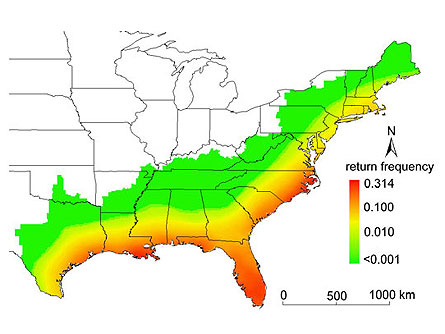Hurricanes and tropical storms kill or damage millions of trees in the United States each year, and that fallen wood and vegetation decomposes, returning more than 90 million metric tons of carbon dioxide to the atmosphere annually, researchers report.

Since 1851, hurricanes or tropical storms have caused damage along the Atlantic seaboard or Gulf Coast in every year except one. These storms, besides causing innumerable deaths and destroying human-built structures, have repeatedly pummeled wide swaths of coastal forests as well as large numbers of inland trees, says Hongcheng Zeng, an ecological geographer at the University of Windsor in Canada.
To assess the effect of this damage on carbon storage in U.S. forests, Zeng, then at Tulane University in New Orleans, and his colleagues used a computer model that estimates wind-related tree mortality across 5-kilometer-by-5-kilometer grid cells. The researchers then inputted information about the paths and strengths of the hurricanes and tropical storms that struck the lower 48 states from 1851 to 2000.
During that time, on average, hurricanes and tropical storms killed or damaged about 97 million trees annually and caused forests to lose about 53 million metric tons of biomass each year. That wood and vegetation will eventually decompose and release about 92 million metric tons of carbon dioxide into the atmosphere, Zeng and his colleagues report online April 27 in the Proceedings of the National Academy of Sciences.
The researchers found, however, that forests suffered much more damage before 1900 than afterward. From 1851 to 1900, storms killed or damaged an average of about 147 million trees each year. But from 1900 to 2000, storms killed or damaged only 72 million trees — about half the damage seen pre-1900. The difference stems largely from changes in land use through time, such as conversion of forests to fields, but can also be attributed in part to an unusual spate of storms that struck the United States late in the 19th century, Zeng notes.
From 1851 to 2000, hurricanes and tropical storms affected forests from central Texas to New England — a swath that covers about 1.75 million square kilometers — but particularly afflicted the southeastern United States, the researchers note. About 1 percent of the total area studied experienced hurricane-force winds, on average, at least once every 50 years.
“This is a good study,” says Maria Uriarte, a forest ecologist at Columbia University. In 2007, her team reported on the effects of hurricanes and tropical storms on the forests in New England, but until now “no one has really done this sort of study on such a large scale,” she notes.
Occasional disturbances to ecosystems — such as hurricanes and tropical storms, wildfires (SN: 6/16/07, p. 378) and insect infestations (SN: 5/10/08, p. 9) — provide “an additional, unpredictable dimension of climate-ecosystem interactions” that most climate models don’t include, says Steven Running, a forest ecologist at the University of Montana in Missoula.
And the effects of those interactions can be substantial: Previous studies have suggested that all together, U.S. forests lock away between 110 million and 150 million tons of carbon each year. Compare that, however, with the damage caused by Hurricane Katrina in 2005. The decomposition of trees killed or damaged by that storm alone will return more than 105 million tons of carbon, or 385 million tons of carbon dioxide, to the atmosphere in the years to come, analyses suggest.
Moreover, for areas very near the coastline, the new study may drastically underestimate a storm’s effect on forests, says Kam-biu Liu, a coastal scientist at Louisiana State University in Baton Rouge. In a 2005 survey of Alabama’s Gulf State Park, just east of where Hurricane Ivan roared ashore the previous year, about 44 percent of the trees were killed by the storm. Oddly, most of those trees remained standing, and many had no broken limbs. That observation, plus the fact that many of the dead trees were rooted in low ground, hints that the trees were killed not by wind but by saltwater forced onshore during the hurricane’s storm surge, Liu and his colleagues report in an upcoming special issue of the Journal of Coastal Research.







